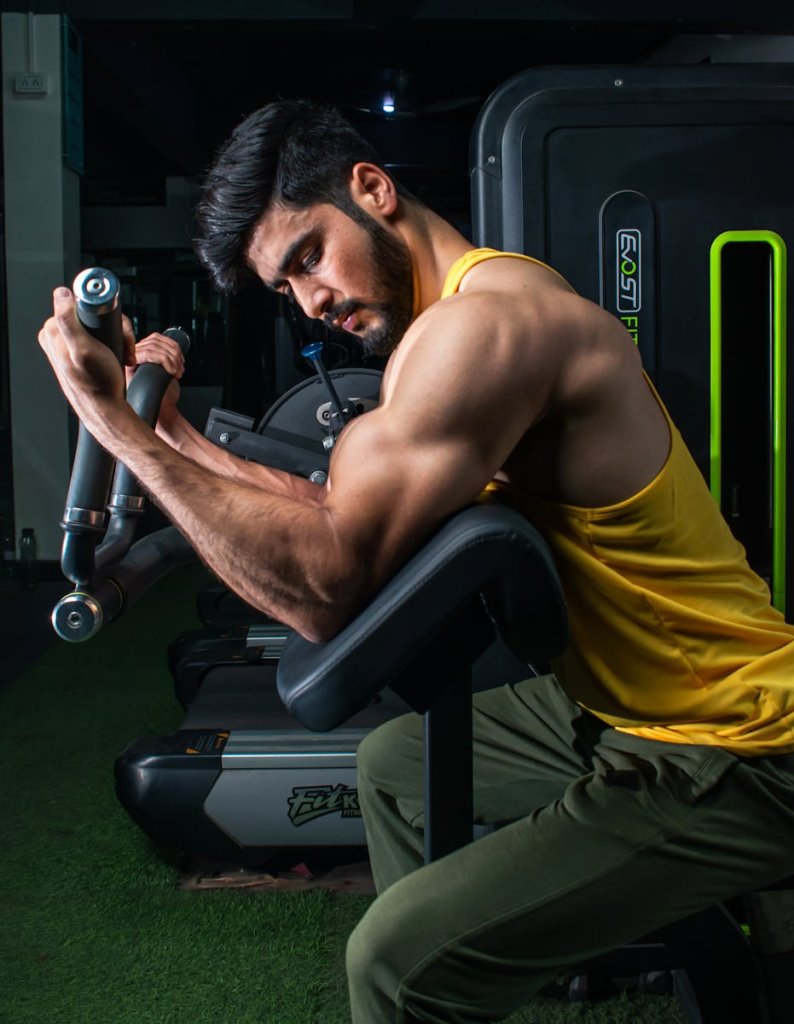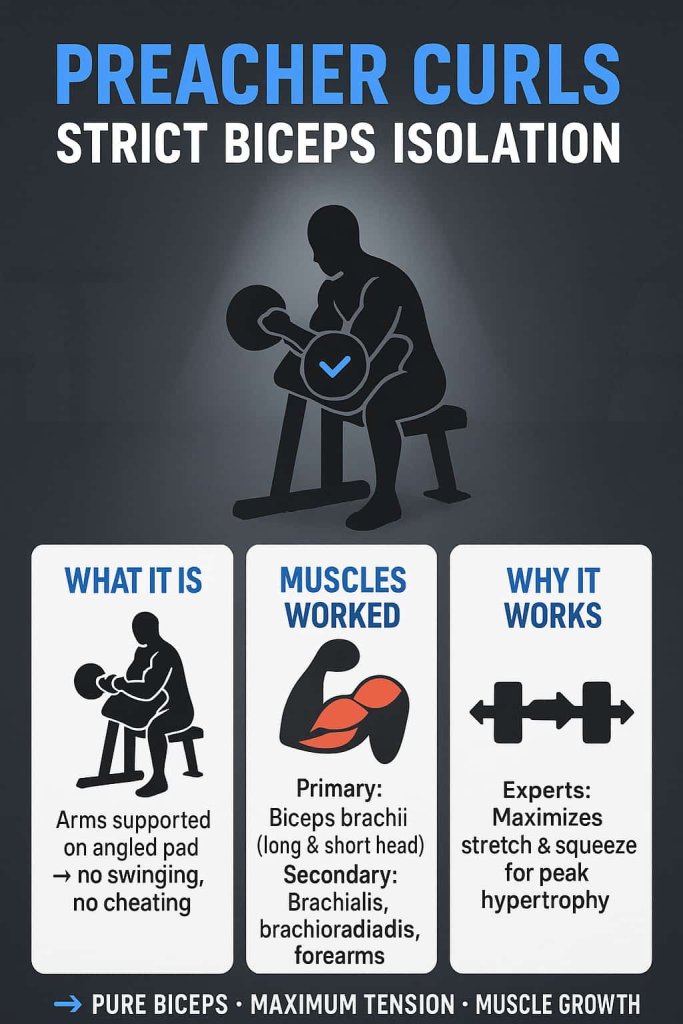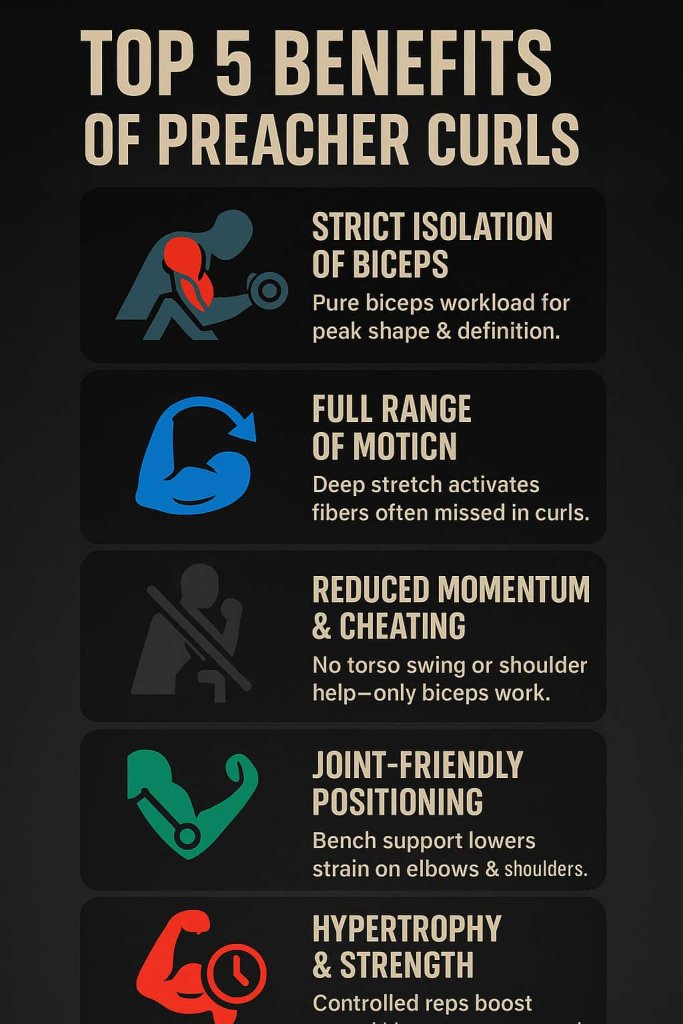Yes, preacher curls are one of the best exercises to isolate and build bigger, stronger biceps. Unlike standing curls where momentum can take over, preacher curls lock your elbows into position, forcing the biceps to do all the work.

Understanding how to perform preacher curls correctly is essential because it ensures maximum muscle activation, reduces injury risk, and helps you achieve sleeve-stretching arms. In this guide, you’ll learn the benefits, proper form, common mistakes, best variations, and how to program preacher curls for growth.
What Are Preacher Curls?
Preacher curls are a biceps isolation exercise performed on a preacher bench, which supports your arms on an angled pad. This setup prevents swinging and makes it nearly impossible to cheat, ensuring pure biceps engagement.

- Primary muscles worked: Biceps brachii (long and short head)
- Secondary muscles: Brachialis, brachioradialis, forearms
👉Experts says, preacher curls maximize the stretch-and-squeeze effect, which is key for hypertrophy.
Benefits of Preacher Curls

- Strict Isolation of Biceps
With arms locked in place, the biceps carry the entire workload—perfect for building peak and definition. - Full Range of Motion
The downward stretch engages muscle fibers that are often missed in standing curls. - Reduced Momentum & Cheating
You can’t swing your torso or use shoulders to lift the weight, making it a true muscle-builder. - Joint-Friendly Positioning
The bench supports your elbows and shoulders, reducing strain compared to free-standing curls. - Hypertrophy & Strength
Controlled reps increase time under tension, a proven driver of muscle growth (GQ Fitness, 2025).
How to Do Preacher Curls (Step by Step)
- Adjust the preacher bench so your chest and armpits rest comfortably at the top edge of the pad.
- Grip the bar (EZ bar or straight bar) underhand, shoulder-width apart.
- Rest your upper arms flat against the pad, elbows locked in place.
- Slowly curl the bar upward while contracting your biceps.
- Pause at the top—squeeze hard.
- Lower the bar under control until your arms are almost straight (not fully locked).
Trainer Tip: Use a 2–3 second eccentric (lowering phase) to maximize muscle tension.
Common Mistakes to Avoid
- Using Too Much Weight → Leads to poor range of motion and strain.
- Elbows Lifting Off Pad → Reduces isolation and increases injury risk.
- Incomplete Range of Motion → Missing the bottom stretch limits growth.
- Rushed Reps → Preacher curls should be controlled and deliberate.
👉 stresses strict form over heavy loading for best results.
Best Preacher Curl Variations
Below are the six best preacher curl variations, explained with benefits, technique, and coaching tips.
1. EZ Bar Preacher Curl
Why it works: The angled grip of the EZ bar reduces wrist stress compared to a straight bar. This makes it more comfortable for most lifters, especially those with tight forearms or previous wrist issues.
Muscles Worked: Biceps brachii (both heads), brachialis, forearms.
How to Do It:
- Sit on the preacher bench and grip the EZ bar on the angled handles.
- Rest your upper arms fully against the pad.
- Curl the bar upward in a controlled motion, squeezing your biceps.
- Lower slowly until your arms are nearly straight.
Trainer Tip: Avoid bouncing at the bottom—keep tension on your biceps by stopping just before your elbows lock out.
2. Straight Bar Preacher Curl
Why it works: The straight bar forces your wrists into full supination (palms up). This increases the stretch and peak contraction of the biceps, especially the short head.
Muscles Worked: Biceps brachii (short head emphasis).
How to Do It:
- Grip a straight bar with palms fully facing upward.
- Perform the curl with strict form, keeping arms flat against the pad.
- Focus on a strong squeeze at the top of the movement.
Trainer Tip: This version places more stress on the wrists—use lighter weight at first until you’re comfortable.
3. Dumbbell Preacher Curl
Why it works: Using dumbbells allows unilateral training, helping correct strength imbalances between arms. It also lets you rotate your wrist slightly during the curl for a more natural motion.
Muscles Worked: Biceps (both heads), brachialis, forearm stabilizers.
How to Do It:
- Sit on the bench and hold one dumbbell at a time, resting the working arm on the pad.
- Curl slowly, rotating the wrist slightly to maximize contraction.
- Perform all reps on one arm, then switch.
Trainer Tip: Try a hammer-style preacher curl with dumbbells (neutral grip) to emphasize the brachialis for thicker arms.
4. Cable Preacher Curl
Why it works: Unlike free weights, cables provide constant tension throughout the entire range of motion. This makes it excellent for hypertrophy since the biceps are never “resting.”
Muscles Worked: Biceps brachii, brachialis.
How to Do It:
- Attach a straight or EZ bar handle to a low pulley cable machine.
- Sit on the preacher bench and hold the bar with an underhand grip.
- Curl smoothly, maintaining control throughout.
Trainer Tip: Use moderate weight and higher reps—cables are ideal for slow, controlled time under tension.
5. Close-Grip Preacher Curl
Why it works: A narrow grip shifts the load toward the long head of the biceps, helping build peak and overall mass.
Muscles Worked: Biceps (long head), brachialis.
How to Do It:
- Grip the bar shoulder-width or closer.
- Curl with elbows tucked in and arms tight against the pad.
- Focus on full extension at the bottom for maximum stretch.
Trainer Tip: Don’t let your elbows flare outward—this reduces long head engagement.
6. Wide-Grip Preacher Curl
Why it works: Taking a wider grip emphasizes the short head of the biceps, which contributes to arm width.
Muscles Worked: Biceps (short head), forearms.
How to Do It:
- Place your hands wider than shoulder-width on the bar.
- Perform slow, controlled curls with constant tension.
- Contract hard at the top to feel the short head working.
Trainer Tip: Don’t go too heavy—wide grips can strain the wrists if overloaded.
Preacher Curls vs. Regular Curls
- Preacher Curl → Better for isolation, strict form, and definition.
- Standing Barbell Curl → Allows heavier loads, contributing to overall size and strength.
Best approach? Combine both in your routine for complete biceps development (Community Strength Austin).
Programming Preacher Curls for Growth
- Sets/Reps: 3–4 sets of 8–12 reps for hypertrophy.
- Tempo: 2 seconds up, 3 seconds down.
- Frequency: 1–2 times per week within an arm or pull workout.
- Supersets: Pair with triceps exercises for balanced arm growth.
Sample Arm Day Superset:
- Preacher Curls (3×12) → Superset with Skull Crushers (3×12).
FAQ: Preacher Curls
1. Are preacher curls better with an EZ bar or straight bar?
EZ bars are easier on the wrists, while straight bars provide stronger peak contraction.
2. Do preacher curls build mass or just definition?
They build both—time under tension promotes hypertrophy, while strict isolation enhances shape.
3. Can beginners do preacher curls?
Yes, start with light dumbbells or EZ bar for proper form.
4. How heavy should I go on preacher curls?
Use a weight you can control for 8–12 reps without elbow lift-off.
5. Should preacher curls replace barbell curls?
No, they complement each other. Use both for maximum biceps development.
6. Are preacher curls safe for elbows?
Yes, if performed correctly. Avoid locking out at the bottom to prevent strain.
7. How do preacher curls compare to concentration curls?
Both isolate the biceps, but preacher curls allow more stability and progressive overload.
Conclusion
Preacher curls are one of the most effective isolation exercises for bigger, stronger biceps. They prevent cheating, increase time under tension, and deliver the kind of targeted growth that standing curls often miss.
👉 Add preacher curls to your arm workouts 1–2 times per week, use controlled form, and mix in variations for balanced development. Your biceps will thank you.
